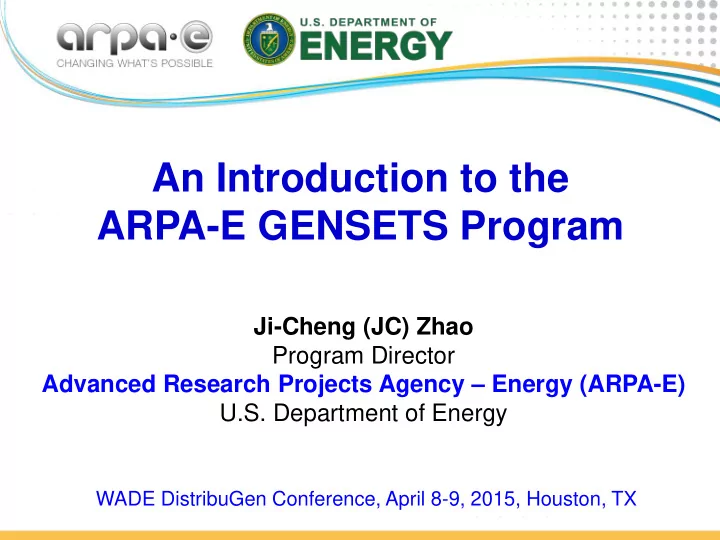

An Introduction to the ARPA-E GENSETS Program Ji-Cheng (JC) Zhao Program Director Advanced Research Projects Agency – Energy (ARPA-E) U.S. Department of Energy WADE DistribuGen Conference, April 8-9, 2015, Houston, TX
Outline • Introduction to ARPA-E • Introduction to GENSETS
Introduction to ARPA-E
Advanced Research Projects Agency - Energy 2013 FY2013 BUDGET $265M Appropriated 2012 FY2012 BUDGET $275M 2011 Appropriated FY2011 BUDGET $180M 2009 Appropriated AMERICAN RECOVERY & 2007 REINVESTMENT ACT AMERICA 2007 $400M COMPETES Appropriated ACT RISING ABOVE THE GATHERING SIGNED STORM PUBLISHED 4
The ARPA-E Mission Ensure America’s Reduce Imports • National Security • Economic Security • Energy Security Improve Reduce • Technological Competiveness Efficiency Emissions Catalyze and support the development of transformational, disruptive energy technologies 5
ARPA-E Inve sts in the De ve lopme nt of Transformational, Disruptive Technologies transformational Steam-powered Cugnot (1769) New York City, 1900 cost / performance Benz Motorwagen (1885) transformational & disruptive existing learning curve tipping point new learning curve Ford Model T (1914) time Technology to Market (T2M) component TRL 3 to TRL 7 6
Introduction to GENSETS (GENerators for Small Electrical and Thermal Systems)
US annual energy use (2013 data) 1 quad ≈ 300 TWh ≈ 300,000 GWh ≈ 300,000,000 MWh 8
US annual electricity generation statistics Nuclear Electricity Hydro Natural gas Waste heat 25.8 Coal 4.7 5.0 4.6 3.4 Natural gas 18.3 • 2 billions tons of CO 2 (38% of US total) 3.3 • 40% of all fresh water withdrawal • 75% used by residential & commercial sectors Simplified 2013 data Sources: LLNL, EIA, EPA
US residential sector annual energy use Combined Heat and Power (CHP) Centralized Electricity Generation 40% electrical efficiency Heat loss 9.7 Quads e - e - 4.7 Quads 4.7 Quads e - 11.7 Quads “19.4 Quads” CHP 11.7 Quads 5 Quads 5 Quads 2 Quads excess heat Overall efficiency: 50% Overall efficiency: 83% • 5 quads of energy savings potential • 200 millions tons of CO 2 reduction (4% US total ≈ 40 M cars) • 8% reduction of US fresh water withdrawal 10
Why haven’t you bought a generator for your home? ~ 500,000 US homes have backup generators <1,000 of 110,000,000 US homes have CHP systems • Low fuel to electricity efficiency (<26%) • High cost for long durability ones (>$6,000) • Low lifetime for low-cost generators (<1 yr) • Large kW size than optimal • Policies and others … 70 million US homes have piped-in natural gas 11
Hourly residential load profile: Chicago 14 14 (b) July (a) January 12 12 10 10 8 8 kW 6 6 Heating Heat from 1 kW e 40% eff. system 4 4 2 2 Hot Water Electricity Electricity 0 0 0 Hour 24 0 Hour 24 Source: NREL BEopt 12
Annual residential load profile: Chicago 16 Chicago Average of Cooling 14 Average of Heating kWh Average of Hot Water kWh 12 Average of Total Electric 10 kW 8 Heat from 3 kW e 40% eff. system 6 4 Heat from 1 kW e 40% eff. system 2 0 January Month December Source: NREL BEopt 13
Annual residential load profiles 16 16 Average of Cooling Average of Cooling 14 14 Average of Heating Average of Heating Average of Hot Water Average of Hot Water 12 Average of Total Electric 12 Average of Total Electric 10 10 Boston Denver kW kW 8 8 6 6 4 4 2 2 0 0 January Month December January Month December 16 16 Average of Cooling Average of Cooling 14 14 Average of Heating Average of Heating Average of Hot Water Average of Hot Water 12 12 Average of Total Electric Average of Total Electric 10 10 kW kW 8 8 Seattle St Louis 6 6 4 4 2 2 0 0 January Month December January Month December 14 Source: NREL BEopt
Annual residential load profiles 16 16 Average of Cooling Average of Cooling 14 14 Average of Heating Average of Heating Average of Hot Water Average of Hot Water 12 Average of Total Electric 12 Average of Total Electric 10 10 Albuquerque Atlanta kW kW 8 8 6 6 4 4 2 2 0 0 January Month December January Month December 16 16 Average of Cooling Average of Cooling 14 14 Average of Heating kWh Average of Heating Average of Hot Water kWh Average of Hot Water 12 Average of Total Electric 12 Average of Total Electric 10 10 kW kW 8 8 Tucson Houston 6 6 4 4 2 2 0 0 January December January Month December Month Source: NREL BEopt 15
Assumptions Techno-economic analysis 1 kW electrical load 1.5 kW heat load 90% capacity factor 4500 $0.005/kWh O&M 10 year lifetime Annual cost [$/year] 4000 $0.11/kWh electricity $10.85/thousand cf NG 3500 Baseline 3000 Capex 1000 2500 Capex 2000 2000 Capex 3000 1500 Capex 4000 1000 Capex 5000 500 Capex 10000 0 0 10 20 30 40 50 60 Additional ~ $1,400 already budgeted for Electrical efficiency [%] meters, other balance of plant & installation 16
CAPEX analysis: MIT study K. Tapia-Ahumada, L.J. Perez-Arriaga, E.J. Moniz, $3,300 Energy Policy , 61 (2013) 496-512 17
GENSETS: GENerators for Small Electrical and Thermal Systems • 1 kW electricity system • 40% electrical efficiency • 10 year durability/life • $ 3,000 system cost • Save energy (~ 5 quads) • Save $ (~ 4-5 year payback) • Reduce CO 2 by 200 million tons • Reduce fresh H 2 O withdrawal (8% of US total) • Increase power resiliency Technologies to enable widespread • $240 billion business opportunity deployment of CHP systems for residential & commercial sectors Improve Efficiency Reduce Emissions Reduce Imports 18 > +25% – 200 million tons
Thank you ! Ji-Cheng (JC) Zhao Program Director Advanced Research Projects Agency – Energy (ARPA-E) U.S. Department of Energy ji-cheng.zhao@doe.gov www.arpa-e.energy.gov 19
Recommend
More recommend